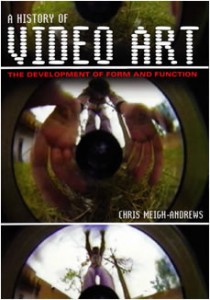A History of Video Art the Development of Form and Function Chris Meighandrews
"A History of Video Art", Berg (Oxford & New York) 2006
A HISTORY OF VIDEO ART. THE DEVELOPMENT OF Form AND Office
The delayed acceptance of video fine art equally a legitimate object for exhibition and report until relatively recently resulted in the arrested evolution of accepted orthodoxies for the history of the fine art form and a famine of major publications on the bailiwick. Unfortunately information technology has also resulted in the loss of many of the works themselves – subject as they are to decay, distortion, the obsolescence of their original technologies and, in some cases, an original artistic intention of impermanence. Both these publications seek to partially redress this situation past providing surveys of the development of the medium, its key figures and key works.
In the more than substantial of the two books, Chris Meigh-Andrews provides a densely detailed account of the progression of video, identifying its theoretical origins in the crossover betwixt the new medium and a plurality of artistic practices: Conceptual Art, Fluxus, Experimental Film, Performance, Minimalism, etc. Nonetheless, this heterogeneity of interconnected conceptual roots for video is contained within the tightly delineated account of the relationship between technological developments and aesthetic response. This technologically determinist reading provides an uncommonly articulate account of innovations in the field and the subsequent possibilities opened upwards to, and by, artists. While this necessarily places the emphasis of the text on 'class and function' information technology also provides a much-needed elaboration (further elucidated in a glossary of technical terms) of the technical details of what was essentially a broadcast medium that evolved at a startling pace.
The book is divided into three sections. The first lays out the historical and cultural context for the international emergence of video. While information technology commences by paying the obligatory homage to the work of Nam June Paik, the extended discussion of the coordinating and influential part of experimental music provides an interesting correlative to the existing discourse on the nascency of the new media. Emphasising the cross-edge nature of video production, Meigh-Andrews surveys the contributions of leading practitioners inside dissimilar countries, managing to account for early developments within Germany, the Netherlands, Italy, France, Poland, United kingdom, Canada and the US. Furthermore, within his discussions on selected artists (the Vasulkas, David Hall, Stephen Brook, Robert Cahen, Peter Donebauer and others), he besides lays out the theoretical touchstones for whatever account of this kind, successfully integrating the work of Benjamin, McLuhan, Norbert Weiner, Experimental Film and theories of Structuralist flick.
The second section of A History of Video Art covers case studies of specific, influential works largely thematised through technical innovation and strategies of exhibition and dissemination. These detailed discussions of videos are particularly fruitful and in many cases refreshingly re-describe the lines of categorisation for certain works from their established identify inside particular discourses – for example, from feminist art do to radical editing strategies.
The final section returns to the theme of technological change and its relationship to wider theoretical issues; information technology ranges from the shift from modernist to postmodernist discourses on art, through a word of the interplay of identity politics, to the pressing contemporary debate on the relevance of drawing distinctions between different moving image practices in the confront of digital product.
The breadth of thematic discussion within the publication does present occasional repetition in terms of specific objects of study – more importantly, nevertheless, it also presents the wealth of knowledge possessed past its author. Meigh-Andrews' own significant contribution to video practice and his obvious familiarity with the British video art scene has resulted in an insightful guide to the development of the medium and the surrounding discourses. The book is an ideal introduction to video for the student or the general reader whilst providing for the historian of contemporary art an effective key for opening up the complexities of the historical, and crucial, technological nuances of the medium in the face up of its full absorption into the digital image.
Meigh-Andrews' painstaking description of the historical relationship between form and function contributes to a growing field of contextualisation for the theorisation of the experience of visual imagery prevalent today.
SAMANTHA LACKEY (2007), The Art Book 14 (3), 63–64 doi:10.1111/j.1467-8357.2007.00851
Source: https://www.meigh-andrews.com/reviews/history-of-video-art
0 Response to "A History of Video Art the Development of Form and Function Chris Meighandrews"
Postar um comentário